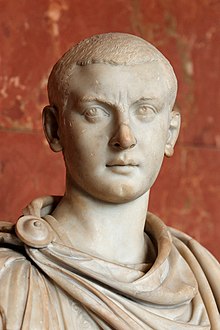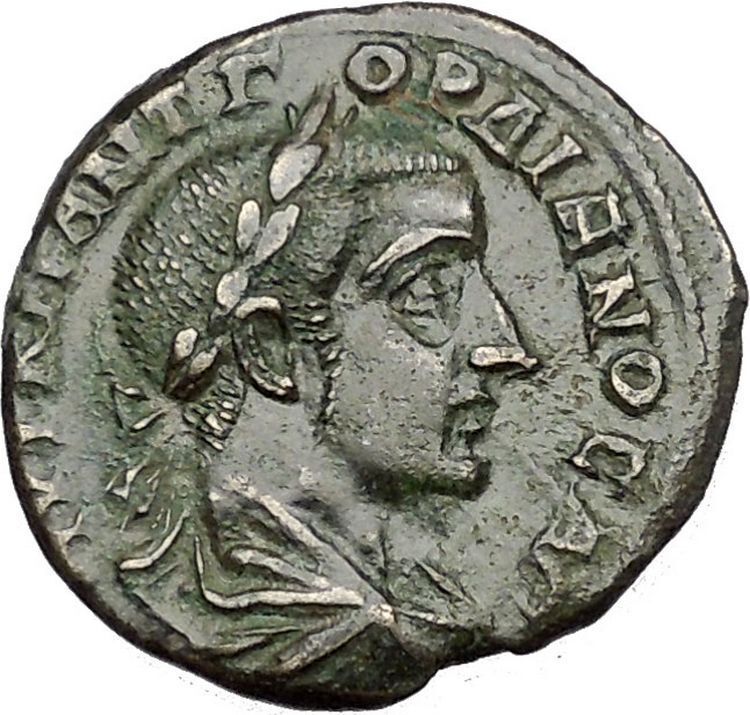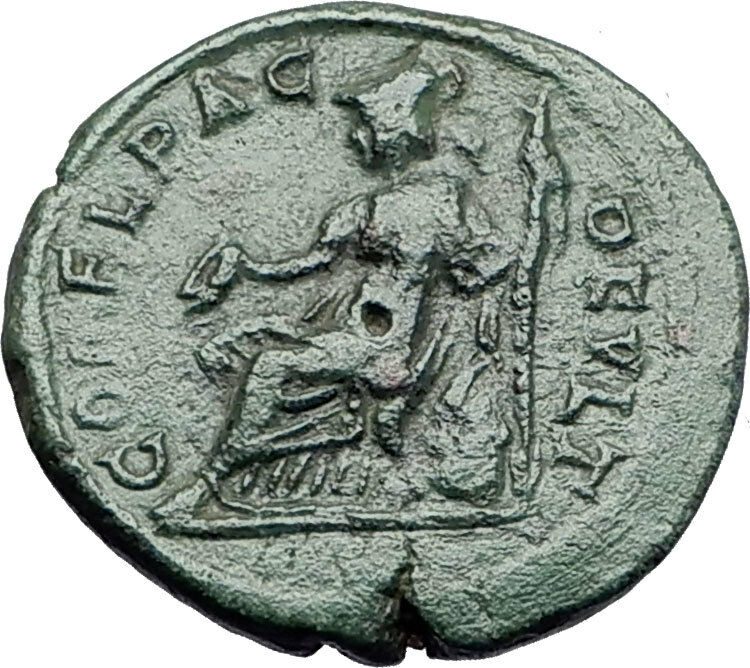|
Gordian III – Roman Emperor: 238-244 A.D.
Gordian III with Serapis
Bronze Pentassarion 24mm (10.06 grams) of Odessos in Thrace
Laureate draped and cuirassed bust of Gordian III on left facing left toward draped bust of Serapis on right wearing kalathos on head and facing left.
OΔHCCEITΩN, Homonoia standing left sacrificing from patera over lit altar and holding cornucopia; E (mark of value) in field to left.
Odessos, also called Odyssus and Odissus at a later time, a Greek town in Thrace (in the later Moesia Inferior) on the Pontus Euxinus nearly due east of Marcianopolis, was founded by Milesians in the territory of the Brobyzi in the reign of Astyages, king of Media (B.C. 594-559). The town possessed a good harbor, and carried on an extensive commerce.
You are bidding on the exact item pictured, provided with a Certificate of Authenticity and Lifetime Guarantee of Authenticity.
 Serapis (Latin spelling, or Sarapis in Greek) was a syncretic Hellenistic-Egyptian god in Antiquity. His most renowned temple was the Serapeum of Alexandria. Under Ptolemy Soter, efforts were made to integrate Egyptian religion with that of their Hellenic rulers. Ptolemy’s policy was to find a deity that should win the reverence alike of both groups, despite the curses of the Egyptian priests against the gods of the previous foreign rulers (i.e Set who was lauded by the Hyksos). Alexander the Great had attempted to use Amun for this purpose, but he was more prominent in Upper Egypt, and not as popular with those in Lower Egypt, where the Greeks had stronger influence. The Greeks had little respect for animal-headed figures, and so a Greek-style anthromorphic statue was chosen as the idol, and proclaimed as the equivalent of the highly popular Apis. It was named Aser-hapi (i.e. Osiris-Apis), which became Serapis, and was said to be Osiris in full, rather than just his Ka (life force). Serapis (Latin spelling, or Sarapis in Greek) was a syncretic Hellenistic-Egyptian god in Antiquity. His most renowned temple was the Serapeum of Alexandria. Under Ptolemy Soter, efforts were made to integrate Egyptian religion with that of their Hellenic rulers. Ptolemy’s policy was to find a deity that should win the reverence alike of both groups, despite the curses of the Egyptian priests against the gods of the previous foreign rulers (i.e Set who was lauded by the Hyksos). Alexander the Great had attempted to use Amun for this purpose, but he was more prominent in Upper Egypt, and not as popular with those in Lower Egypt, where the Greeks had stronger influence. The Greeks had little respect for animal-headed figures, and so a Greek-style anthromorphic statue was chosen as the idol, and proclaimed as the equivalent of the highly popular Apis. It was named Aser-hapi (i.e. Osiris-Apis), which became Serapis, and was said to be Osiris in full, rather than just his Ka (life force).
History
The earliest mention of a Serapis is in the disputed death scene of Alexander (323 BC). Here, Serapis has a temple at Babylon, and is of such importance that he alone is named as being consulted on behalf of the dying king. His presence in Babylon would radically alter perceptions of the mythologies of this era, though fortunately it has been discovered that the unconnected Babylonian god Ea (Enki) was titled Serapsi, meaning king of the deep, and it is possibly this Serapsi which is referred to in the diaries. The significance of this Serapsi in the Hellenic psyche, due to its involvement in Alexander’s death, may have also contributed to the choice of Osiris-Apis as the chief Ptolemaic god.
According to Plutarch, Ptolemy stole the cult statue from Sinope, having been instructed in a dream by the unknown god, to bring the statue to Alexandria, where the statue was pronounced to be Serapis by two religious experts. One of the experts was of the Eumolpidae, the ancient family from whose members the hierophant of the Eleusinian Mysteries had been chosen since before history, and the other was the scholarly Egyptian priest Manetho, which gave weight to the judgement both for the Egyptians and the Greeks.
Plutarch may not however be correct, as some Egyptologists allege that the Sinope in the tale is really the hill of Sinopeion, a name given to the site of the already existing Serapeum at Memphis. Also, according to Tacitus, Serapis (i.e. Apis explicitly identified as Osiris in full) had been the god of the village of Rhakotis, before it suddenly expanded into the great capital of Alexandria.
The statue suitably depicted a figure resembling Hades or Pluto, both being kings of the Greek underworld, and was shown enthroned with the modius, a basket/grain-measure, on his head, since it was a Greek symbol for the land of the dead. He also held a sceptre in his hand indicating his rulership, with Cerberus, gatekeeper of the underworld, resting at his feet, and it also had what appeared to be a serpent at its base, fitting the Egyptian symbol of rulership, the uraeus.
With his (i.e. Osiris’) wife Isis, and their son (at this point in history) Horus (in the form of Harpocrates), Serapis won an important place in the Greek world, reaching Ancient Rome, with Anubis being identified as Cerberus. In Rome, Serapis was worshiped in the Iseum Campense, the sanctuary of the goddess Isis located in the Campus Martius and built during the Second Triumvirate. The Roman cults of Isis and Serapis gained in popularity late in the first century thanks to the god’s role in the miracles that the imperial usurper Vespasian experienced in the city of Alexandria, where he stayed prior to his return to Rome as emperor in 70 AD. From the Flavian Dynasty on, Serapis sometimes appeared on imperial coinage with the reigning emperor. The great cult survived until 385, when a Christian mob destroyed the Serapeum of Alexandria, and subsequently the cult was forbidden by the Theodosian decree.
The early Alexandrian Christian community appears to have been rather syncretic in their worship of Serapis and Jesus and would prostrate themselves without distinction between the two. A letter inserted in the Augustan History, ascribed to the Emperor Hadrian, refers to the worship of Serapis by residents of Egypt who described themselves as Christians, and Christian worship by those claiming to worship Serapis, suggesting a great confusion of the cults and practices:
The land of Egypt, the praises of which you have been recounting to me, my dear Servianus, I have found to be wholly light-minded, unstable, and blown about by every breath of rumour. There those who worship Serapis are, in fact, Christians, and those who call themselves bishops of Christ are, in fact, devotees of Serapis. There is no chief of the Jewish synagogue, no Samaritan, no Christian presbyter, who is not an astrologer, a soothsayer, or an anointer. Even the Patriarch himself, when he comes to Egypt, is forced by some to worship Serapis, by others to worship Christ.
Homonoia, in ancient Greek religion, was a minor goddess of concord, unanimity, and oneness of mind. Her opposite number was Eris (Strife).
Homonoia was believed to be the daughter of Soter, the saviour daimon, and Praxidike, the goddess of judicial punishment and vengeance. Her siblings were Arete (a goddess personifying virtue) and Ktesios, minor god of household. Arete and Homonoia were referred to as the Praxidikai, taking this name after their mother. As such Homonoia was probably closely identified with the Theban Goddess-Queen Harmonia.
The region of ancient Thrace was populated by Thracians by 1000 BCE. Miletian Greeks founded the apoikia (trading post) of Odessòs towards the end of the 7th century BC (the earliest Greek archaeological material is dated 600-575 BCE), or, according to Pseudo-Scymnus, in the time of Astyages (here, usually 572-570 BCE is suggested), within an earlier Thracian settlement. The name Odessos was pre-Greek, arguably of Carian origin. A member of the Pontic Pentapolis, Odessos was a mixed community-contact zone between the Ionian Greeks and the Thracian tribes (Getae, Krobyzoi, Terizi) of the hinterland. Excavations at nearby Thracian sites have shown uninterrupted occupation from the 7th to the 4th century and close commercial relations with the colony. The Greek alphabet has been applied to inscriptions in Thracian since at least the 5th century BCE; the city worshipped a Thracian great god whose cult survived well into the Roman period.
Odessos was included in the assessment of the Delian league of 425 BCE. In 339 BCE, it was unsuccessfully besieged by Philip II (priests of the Getae persuaded him to conclude a treaty) but surrendered to Alexander the Great in 335 BCE, and was later ruled by his diadochus Lysimachus, against whom it rebelled in 313 BC as part of a coalition with other Pontic cities and the Getae. The Roman city, Odessus, first included into the Praefectura orae maritimae and then in 15 CE annexed to the province of Moesia (later Moesia Inferior), covered 47 hectares in present-day central Varna and had prominent public baths, Thermae, erected in the late 2nd century AD, now the largest Roman remains in Bulgaria (the building was 100 m (328.08 ft) wide, 70 m (229.66 ft) long, and 25 m (82.02 ft) high) and fourth-largest known Roman baths in Europe. Major athletic games were held every five years, possibly attended by Gordian III in 238 CE.
Odessus was an early Christian centre, as testified by ruins of ten early basilicas, a monophysite monastery, and indications that one of the Seventy Disciples, Ampliatus, follower of Saint Andrew (who, according to the Bulgarian Orthodox Church legend, preached in the city in 56 CE), served as bishop there. In 6th-century CE imperial documents, it was referred to as “holiest city,” sacratissima civitas. In 442 CE, a peace treaty between Theodosius II and Attila was done at Odessus. In 513, it became a focal point of the Vitalian revolt. In 536, Justinian I made it the seat of the Quaestura exercitus ruled by a prefect of Scythia or quaestor Justinianus and including Lower Moesia, Scythia, Caria, the Aegean Islands and Cyprus; later, the military camp outside Odessus was the seat of another senior Roman commander, magister militum per Thracias.
It has been suggested that the 681 peace treaty with the Byzantine Empire that established the new Bulgarian state was concluded at Varna and the first Bulgarian capital south of the Danube may have been provisionally located in its vicinity-possibly in an ancient city near Lake Varna’s north shore named Theodorias (Θεοδωριάς) by Justinian I-before it moved to Pliska 70 kilometres (43 miles) to the west. Asparukh fortified the Varna river lowland by a rampart against a possible Byzantine landing; the Asparuhov val (Asparukh’s Wall) is still standing. Numerous 7th-century Bulgar settlements have been excavated across the city and further west; the ; the Varna lakes north shores, of all regions, were arguably most densely populated by Bulgars. It has been suggested that Asparukh was aware of the importance of the Roman military camp (campus tribunalis) established by Justinian I outside Odessus and considered it (or its remnants) as the legitimate seat of power for both Lower Moesia and Scythia.
Gordian III – Roman Emperor: 238-244 A.D.
Caesar: 238 A.D. (under Balbinus and Pupienus)
Augustus: 238-244 A.D.
| Grandson of Gordian I | Nephew of Gordian II | Adopted Successor of Balbinus and Pupienus | Husband of Tranquillina |

Gordian III (Latin: Marcus Antonius Gordianus Pius Augustus; 20 January 225 AD – 11 February 244 AD) was Roman Emperor from 238 AD to 244 AD. At the age of 13, he became the youngest sole legal Roman emperor throughout the existence of the united Roman Empire. Gordian was the son of Antonia Gordiana and an unnamed Roman Senator who died before 238. Antonia Gordiana was the daughter of Emperor Gordian I and younger sister of Emperor Gordian II. Very little is known of his early life before his acclamation. Gordian had assumed the name of his maternal grandfather in 238 AD.
In 235, following the murder of Emperor Alexander Severus in Moguntiacum (modern Mainz), the capital of the Roman province Germania Superior, Maximinus Thrax was acclaimed Emperor. In the following years, there was a growing opposition against Maximinus in the Roman senate and amongst the majority of the population of Rome. In 238 a rebellion broke out in the Africa Province, where Gordian’s grandfather and uncle, Gordian I and II, were proclaimed joint emperors. This revolt was suppressed within a month by Cappellianus, governor of Numidia and a loyal supporter of Maximinus Thrax. The elder Gordians died, but public opinion cherished their memory as peace-loving and literate men, victims of Maximinus’ oppression.
Meanwhile, Maximinus was on the verge of marching on Rome and the Senate elected Pupienus and Balbinus as joint emperors. These senators were not popular men and the population of Rome was still shocked by the elder Gordian’s fate, so the Senate decided to take the teenager Gordian, rename him Marcus Antonius Gordianus like his grandfather, and raise him to the rank of Caesar and imperial heir. Pupienus and Balbinus defeated Maximinus, mainly due to the defection of several legions, particularly the II Parthica, who assassinated Maximinus. However, their joint reign was doomed from the start with popular riots, military discontent and an enormous fire that consumed Rome in June 238. On July 29, Pupienus and Balbinus were killed by the Praetorian Guard and Gordian proclaimed sole emperor.
Rule
Due to Gordian’s age, the imperial government was surrendered to the aristocratic families, who controlled the affairs of Rome through the Senate. In 240, Sabinianus revolted in the African province, but the situation was quickly brought under control. In 241, Gordian was married to Furia Sabinia Tranquillina, daughter of the newly appointed praetorian prefect, Timesitheus. As chief of the Praetorian Guard and father in law of the Emperor, Timesitheus quickly became the de facto ruler of the Roman Empire.
In the 3rd century, the Roman frontiers weakened against the Germanic tribes across the Rhine and Danube, and the Sassanid Empire across the Euphrates increased its own attacks. When the Persians under Shapur I invaded Mesopotamia, the young emperor opened the doors of the Temple of Janus for the last time in Roman history, and sent a large army to the East. The Sassanids were driven back over the Euphrates and defeated in the Battle of Resaena (243). The campaign was a success and Gordian, who had joined the army, was planning an invasion of the enemy’s territory, when his father-in-law died in unclear circumstances. Without Timesitheus, the campaign, and the Emperor’s security, were at risk.
Gaius Julius Priscus and, later on, his own brother Marcus Julius Philippus, also known as Philip the Arab, stepped in at this moment as the new Praetorian Prefects and the campaign proceeded. Around February 244, the Persians fought back fiercely to halt the Roman advance to Ctesiphon. Persian sources claim that a battle occurred (Battle of Misiche) near modern Fallujah (Iraq) and resulted in a major Roman defeat and the death of Gordian III. Roman sources do not mention this battle and suggest that Gordian died far away from Misiche, at Zaitha (Qalat es Salihiyah) in northern Mesopotamia. Modern scholarship does not unanimously accept this course of the events. One view holds that Gordian died at Zaitha, murdered by his frustrated army, while the role of Philip is unknown. Other scholars, such as Kettenhofen, Hartman and Winter have concluded that Gordian died in battle against the Sassanids.
Philip transferred the body of the deceased emperor to Rome and arranged for his deification. Gordian’s youth and good nature, along with the deaths of his grandfather and uncle and his own tragic fate at the hands of the enemy, earned him the lasting esteem of the Romans. The soldiers held Gordian in high esteem, as he had possibly sacrificed his life to save them in 244.
|




 Serapis (Latin spelling, or Sarapis in Greek) was a syncretic Hellenistic-Egyptian god in Antiquity. His most renowned temple was the Serapeum of Alexandria. Under Ptolemy Soter, efforts were made to integrate Egyptian religion with that of their Hellenic rulers. Ptolemy’s policy was to find a deity that should win the reverence alike of both groups, despite the curses of the Egyptian priests against the gods of the previous foreign rulers (i.e Set who was lauded by the Hyksos). Alexander the Great had attempted to use Amun for this purpose, but he was more prominent in Upper Egypt, and not as popular with those in Lower Egypt, where the Greeks had stronger influence. The Greeks had little respect for animal-headed figures, and so a Greek-style anthromorphic statue was chosen as the idol, and proclaimed as the equivalent of the highly popular Apis. It was named Aser-hapi (i.e. Osiris-Apis), which became Serapis, and was said to be Osiris in full, rather than just his Ka (life force).
Serapis (Latin spelling, or Sarapis in Greek) was a syncretic Hellenistic-Egyptian god in Antiquity. His most renowned temple was the Serapeum of Alexandria. Under Ptolemy Soter, efforts were made to integrate Egyptian religion with that of their Hellenic rulers. Ptolemy’s policy was to find a deity that should win the reverence alike of both groups, despite the curses of the Egyptian priests against the gods of the previous foreign rulers (i.e Set who was lauded by the Hyksos). Alexander the Great had attempted to use Amun for this purpose, but he was more prominent in Upper Egypt, and not as popular with those in Lower Egypt, where the Greeks had stronger influence. The Greeks had little respect for animal-headed figures, and so a Greek-style anthromorphic statue was chosen as the idol, and proclaimed as the equivalent of the highly popular Apis. It was named Aser-hapi (i.e. Osiris-Apis), which became Serapis, and was said to be Osiris in full, rather than just his Ka (life force). 





